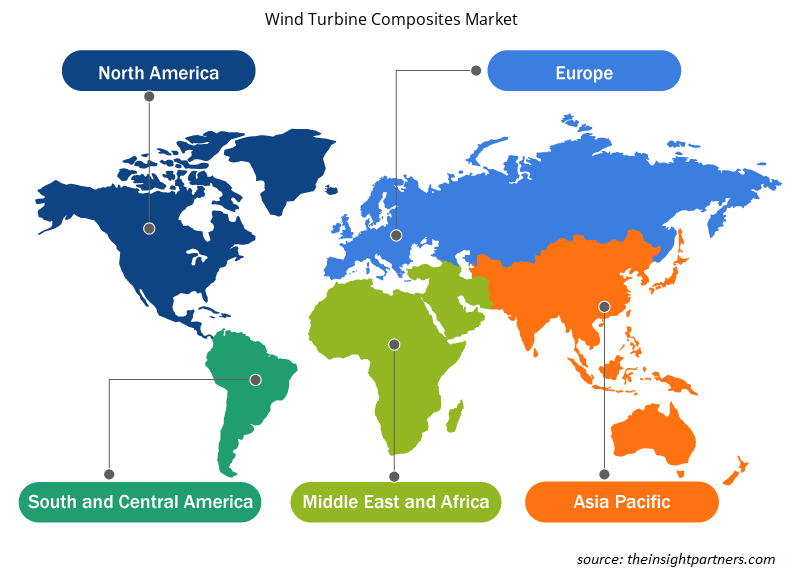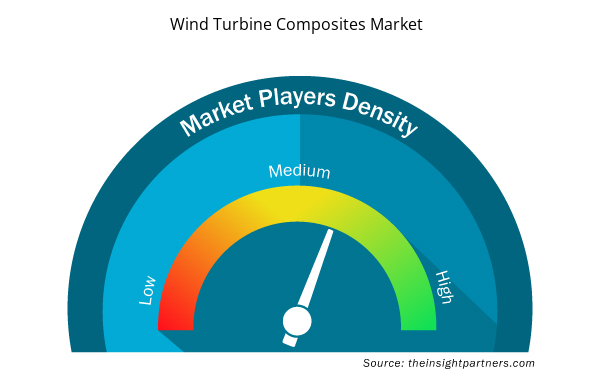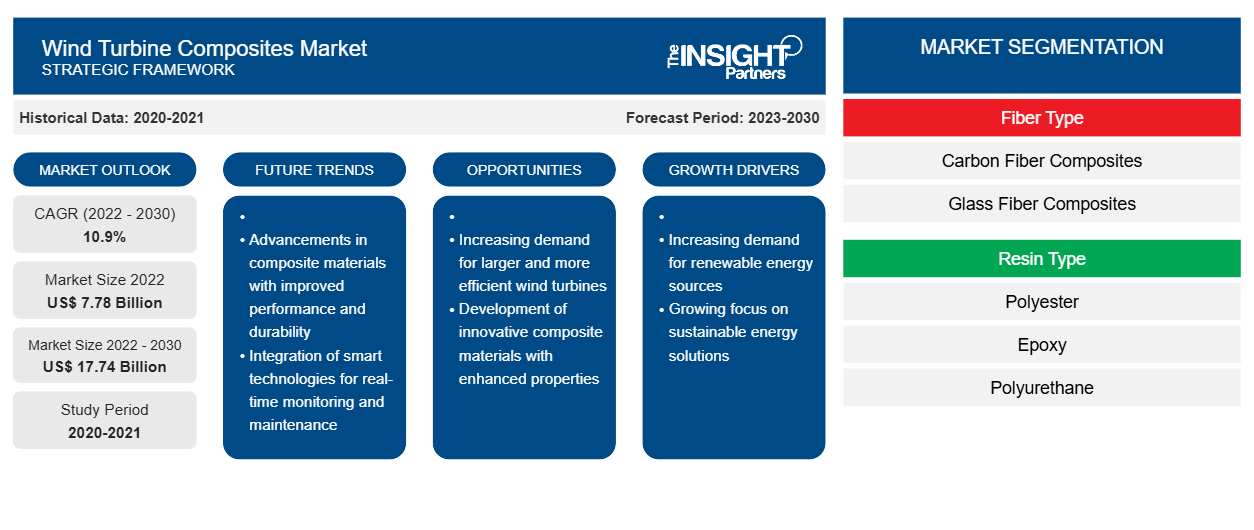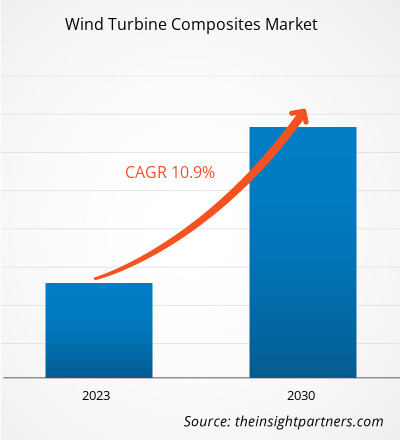[調査レポート] 風力タービン複合材の市場規模は2022年に77億7,737万米ドルと評価され、2030年までに177億4,086万米ドルに達すると予測されています。また、2022年から2030年にかけて10.9%のCAGRを記録すると予想されています。
市場分析
風力タービン複合材は、ブレードやナセルなどの風力タービン部品の製造に利用される複合材または部品として定義されます。複合材を使用すると、優れた特性、低いメンテナンス費用、耐腐食性、製品の長寿命を備えた軽量部品の製造に役立ちます。再生可能エネルギーへの注目の高まり、さまざまな最終用途産業からの風力タービン複合材の需要の増加、風力エネルギープロジェクトを支援する政府の積極的な取り組みは、今後数年間で世界市場で風力タービン複合材の需要が増加すると予想されるいくつかの要因です。
成長の原動力と課題
風力は、燃料を燃やしたり空気を汚染したりすることなく電力を供給するクリーンで再生可能なエネルギー源と考えられています。風力エネルギーは化石燃料への依存を減らすのに役立ちます。そのため、さまざまな国で風力エネルギーへの関心が高まっており、その結果、風力発電の設置容量が急速に増加しています。
下図に示すように、2020年の世界全体の新規風力発電設備は90GWを超え、2019年と比較して53%の成長を記録し、総設備容量は743GWとなり、前年と比較して14%の増加となりました。2020年の陸上風力発電所の新規設備は86.9GWに達し、洋上風力発電所は6.1GWに達し、2020年は陸上と洋上の新規風力発電設備にとってそれぞれ史上最高と2番目に高い年となりました。
世界風力エネルギー協議会によると、米国は2020年に他のどの年よりも風力タービンの容量を拡大しました。米国の風力産業は2021年に風力容量を13,413メガワット(MW)増加し、累計135,886MWに達しました。これは、2020年に次いで米国で1年間に設置された風力容量としては2番目に高いものです。世界中のさまざまな国の政府も、生産税額控除(PTC)の助けを借りて納税者の給与を大量に補助することで風力発電を支援しています。したがって、ほとんどの再生可能エネルギー産業は、納税者の絶え間ない支援に加えて、政府が提供する補助金に大きく依存しています。ただし、これらの風力設備のほとんどはオープンマーケットでは経済的ではなく、補助金の終わりのないサイクルにつながっています。また、政府からの保証された補助金と利益の助けを借りずに、再生可能エネルギー業界は信頼性、効率性、費用対効果を向上させるためのイノベーションに注力しています。したがって、風力エネルギーは政府の補助金と税還付に大きく依存しており、それが市場の成長を制限しています。
要件に合わせてレポートをカスタマイズする
このレポートの一部、国レベルの分析、Excelデータパックなど、あらゆるレポートを無料でカスタマイズできます。また、スタートアップや大学向けのお得なオファーや割引もご利用いただけます。
- このレポートの主要な市場動向を入手してください。この無料サンプルには、市場動向から見積もりや予測に至るまでのデータ分析が含まれます。
レポートのセグメンテーションと範囲
「2030 年までの世界の風力タービン複合材市場予測」は、世界の風力タービン複合材市場の動向と機会に主に焦点を当てた専門的で詳細な調査です。このレポートは、繊維の種類、樹脂の種類、技術、用途、および地域に基づいて詳細な市場区分で市場の概要を提供することを目的としています。世界の風力タービン複合材市場は、最近高い成長を遂げており、予測期間中もこの傾向が続くと予想されています。このレポートでは、世界中の風力タービン複合材の使用に関する主要な統計と、主要な地域および国での需要を提供しています。さらに、主要な地域および国での風力タービン複合材市場のパフォーマンスに影響を与えるさまざまな要因の定性的な評価も提供しています。このレポートには、主要な市場プレーヤーとその主要な戦略的開発に関する包括的な分析も含まれています。また、主要な推進要因、市場動向、および収益性の高い風力タービン複合材市場の機会を特定するために役立つ、市場ダイナミクスに関するいくつかの分析も含まれています。
さらに、エコシステム分析とポーターの 5 つの力の分析により、世界の風力タービン複合材市場の 360 度の視点が得られ、サプライ チェーン全体と市場の成長に影響を与えるさまざまな要因を理解するのに役立ちます。
セグメント分析
世界の風力タービン複合材市場は、繊維の種類、樹脂の種類、技術、用途に基づいて分類されています。繊維の種類では、市場は炭素繊維複合材、ガラス繊維複合材、その他に分類されています。樹脂の種類では、市場はポリエステル、エポキシ、ポリウレタン、ビニルエステルなどに分類されています。技術の面では、世界の風力タービン複合材市場は、樹脂注入、プリプレグ、レイアップなどに分類されています。用途別では、市場はブレードとナセルに分かれています。
繊維の種類に基づいて、ガラス繊維複合材セグメントは、2022年に世界の風力タービン複合材市場で大きなシェアを占めました。ガラス繊維複合材は、ガラス繊維で強化された熱硬化性プラスチック樹脂です。ガラス繊維複合材は、さまざまな製造技術によって生産され、幅広い用途に使用されています。ガラス繊維は、高強度、柔軟性、耐久性、化学的損傷に対する耐性など、いくつかの特性を備えています。それらは、ロービング、チョップドストランド、糸、織物、およびマットの形をとることができます。樹脂の種類別では、エポキシセグメントが2022年に世界の風力タービン複合材市場で最大のシェアを占めました。エポキシ樹脂は、硬化中に高い強度と低い収縮を示します。靭性と耐薬品性のため、これらはブレードの製造に広く使用されています。配合に応じて、エポキシ樹脂は、グラスファイバーまたは複合構造の鋳造、樹脂バインダー、ポッティング剤、およびラミネート樹脂として使用されます。技術別では、樹脂注入セグメントが2022年に風力タービン複合材市場を支配しました。樹脂注入成形プロセスは、複雑な翼形形状、大きなサイズ、および費用対効果のため、大型の熱硬化性複合材風力ローターブレードの製造に広く導入されています。樹脂注入技術の採用は、風力タービン複合材の品質の向上に役立っています。用途別では、ブレードセグメントが2022年に最大の市場シェアで世界の風力タービン複合材市場をリードしました。風力タービンブレードは、風力エネルギーを利用して風力タービンのローターを駆動する翼形ブレードとして定義されます。翼形のデザインは、ブレードの風向に対して垂直な揚力を適用します。風力タービンブレードは、風力タービンの最も重要でありながら重要な部分であると考えられています。
地域分析
このレポートでは、北米、ヨーロッパ、アジア太平洋 (APAC)、中東およびアフリカ (MEA)、南米および中米の 5 つの主要地域に関して、世界の風力タービン複合材市場の詳細な概要を提供しています。APAC は世界の風力タービン複合材市場シェアのかなりの部分を占めており、2022 年には 30 億米ドルを超えると評価されました。アジア太平洋地域の風力タービン複合材市場は、オーストラリア、中国、インド、日本、韓国、その他のアジア太平洋地域に分かれています。中国はこの地域の市場成長に大きく貢献しています。同国は 10 年以上にわたり、世界最大かつ最も急速に成長している再生可能エネルギー生産国です。ヨーロッパも著しい成長が見込まれており、2030 年までに約 40 億米ドルに達します。ヨーロッパの風力タービン複合材市場は、ドイツ、フランス、イタリア、英国、ロシア、その他のヨーロッパに分かれています。この地域のさまざまな国が、持続可能性の目標を達成するために技術力を活用しています。さらに、北米では、風力タービン複合材が広く使用されています。これにより、風力タービン複合材市場に有利な機会が生まれています。北米の風力タービン複合材市場は、2022年から2030年にかけて約11%のCAGRで成長すると予想されています。
業界の発展と将来の機会
パートナーシップ、買収、新製品の発売は、世界の風力タービン複合材市場で活動する企業が採用しているいくつかの主要な戦略です。
2022年4月、Avient CorporationはDSM Protective Materialsの買収を発表し、同社のDyneemaブランドと独自の技術をAvientに追加しました。この買収は、成長を続ける複合材料ポートフォリオの拡大を目的としていました。Avient Corporationはまた、Avient Distribution事業の売却オプションを検討する計画も発表しました。
COVID-19パンデミックの影響/地政学的シナリオの影響/景気後退の影響
COVID-19パンデミックによるロックダウン、渡航制限、事業停止は、世界中のさまざまな国の経済や産業に悪影響を及ぼしました。この危機は、サプライチェーン、製造活動、納期、必須および非必須の製品の販売に支障をきたしました。これらの混乱により、風力タービン複合材の入手が制限されました。生産の遅れとコストの増加を引き起こし、風力タービン複合材の全体的な供給に悪影響を及ぼしました。多くの製造施設は、ロックダウン措置に従い、労働者の安全を確保するために、COVID-19パンデミック中に一時的に停止または規模を縮小しました。さらに、パンデミックは世界経済に影響を与え、商品価格の変動や樹脂と繊維の需要の減少につながりました。
各国政府が規制緩和を発表したことで、世界市場は損失から回復しつつあります。各国がパンデミックから徐々に回復し、ワクチン接種の取り組みが続く中、製造活動は回復しています。メーカーは供給ギャップを克服するためにフル稼働することが許可されています。多くの地域でインフラ投資の増加と景気刺激策が複合材の需要を牽引しています。したがって、世界の風力タービン複合材市場は予測期間中に大幅に成長すると予想されます。
風力タービン複合材料市場の地域別分析
予測期間を通じて風力タービン複合材市場に影響を与える地域的な傾向と要因は、Insight Partners のアナリストによって徹底的に説明されています。このセクションでは、北米、ヨーロッパ、アジア太平洋、中東、アフリカ、南米、中米にわたる風力タービン複合材市場のセグメントと地理についても説明します。

- 風力タービン複合材料市場の地域別データを入手
風力タービン複合材料市場レポートの範囲
| レポート属性 | 詳細 |
|---|---|
| 2022年の市場規模 | 77億8千万米ドル |
| 2030年までの市場規模 | 177.4億米ドル |
| 世界のCAGR(2022年 - 2030年) | 10.9% |
| 履歴データ | 2020-2021 |
| 予測期間 | 2023-2030 |
| 対象セグメント | 繊維の種類別
|
| 対象地域と国 | 北米
|
| 市場リーダーと主要企業プロフィール |
|
風力タービン複合材料市場のプレーヤー密度:ビジネスダイナミクスへの影響を理解する
風力タービン複合材料市場は、消費者の嗜好の変化、技術の進歩、製品の利点に対する認識の高まりなどの要因により、エンドユーザーの需要が高まり、急速に成長しています。需要が高まるにつれて、企業は提供を拡大し、消費者のニーズを満たすために革新し、新たなトレンドを活用し、市場の成長をさらに促進しています。
市場プレーヤー密度とは、特定の市場または業界内で活動している企業または会社の分布を指します。これは、特定の市場スペースに、その規模または総市場価値と比較して、どれだけの競合相手 (市場プレーヤー) が存在するかを示します。
風力タービン複合材料市場で事業を展開している主要企業は次のとおりです。
- アビエント社
- 東レ株式会社
- SGLカーボンSE
- オーウェンス・コーニング
- グリットホールディングAG
免責事項:上記の企業は、特定の順序でランク付けされていません。

- 風力タービン複合材料市場のトップキープレーヤーの概要を入手
競争環境と主要企業
Avient Corp、Toray Industries Inc、SGL Carbon SE、Owens Corning、Gurit Holding AG、Hexion Inc、Hexcel Corp、Exel Composites Oyj、EPSILON Composite SA、およびCovestro AGは、世界の風力タービン複合材市場で活動している主要企業の一部です。
- 過去2年間の分析、基準年、CAGRによる予測(7年間)
- PEST分析とSWOT分析
- 市場規模価値/数量 - 世界、地域、国
- 業界と競争環境
- Excel データセット



Report Coverage
Revenue forecast, Company Analysis, Industry landscape, Growth factors, and Trends

Segment Covered
This text is related
to segments covered.

Regional Scope
North America, Europe, Asia Pacific, Middle East & Africa, South & Central America

Country Scope
This text is related
to country scope.
よくある質問
The resin infusion held the largest share of the market in 2022. The resin infusion molding process is extensively deployed in producing large thermoset composite wind rotor blades owing to their complex airfoil geometry, large sizes, and cost-effectiveness. The adoption of resin infusion technologies has helped improve the quality of wind turbine composites.
In 2022, Asia Pacific held the largest revenue share of the global wind turbine composites market. The wind turbine composites market growth in Australia, China, India, and Japan is attributed to growing wind energy industry in the region.
The major players operating in the global wind turbine composites market are Avient Corp, Toray Industries Inc, SGL Carbon SE, Owens Corning, Gurit Holding AG,Hexion Inc, Hexcel Corp, Exel Composites Oyj, EPSILON Composite SA, Covestro AG.
The epoxy segment held the largest share of the market in 2022. Epoxy resins show high strength and low shrinkage during curing. Due to their toughness and chemical resistance, these are widely used in manufacturing blades. Depending on the formulation, epoxy resins are used as casting, resin binders, potting agents, and laminating resins in fiberglass or composite construction.
The blades held the largest share of the market in 2022. Blades are composed of fiberglass-reinforced polyester or epoxy. Carbon fiber or aramid is also utilized as a reinforcement material.
Trends and growth analysis reports related to Chemicals and Materials : READ MORE..
The List of Companies - Wind Turbine Composites Market
- Avient Corp
- Toray Industries Inc
- SGL Carbon SE
- Owens Corning
- Gurit Holding AG
- Hexion Inc
- Hexcel Corp
- Exel Composites Oyj
- EPSILON Composite SA
- Covestro AG
The Insight Partners performs research in 4 major stages: Data Collection & Secondary Research, Primary Research, Data Analysis and Data Triangulation & Final Review.
- Data Collection and Secondary Research:
As a market research and consulting firm operating from a decade, we have published and advised several client across the globe. First step for any study will start with an assessment of currently available data and insights from existing reports. Further, historical and current market information is collected from Investor Presentations, Annual Reports, SEC Filings, etc., and other information related to company’s performance and market positioning are gathered from Paid Databases (Factiva, Hoovers, and Reuters) and various other publications available in public domain.
Several associations trade associates, technical forums, institutes, societies and organization are accessed to gain technical as well as market related insights through their publications such as research papers, blogs and press releases related to the studies are referred to get cues about the market. Further, white papers, journals, magazines, and other news articles published in last 3 years are scrutinized and analyzed to understand the current market trends.
- Primary Research:
The primarily interview analysis comprise of data obtained from industry participants interview and answers to survey questions gathered by in-house primary team.
For primary research, interviews are conducted with industry experts/CEOs/Marketing Managers/VPs/Subject Matter Experts from both demand and supply side to get a 360-degree view of the market. The primary team conducts several interviews based on the complexity of the markets to understand the various market trends and dynamics which makes research more credible and precise.
A typical research interview fulfils the following functions:
- Provides first-hand information on the market size, market trends, growth trends, competitive landscape, and outlook
- Validates and strengthens in-house secondary research findings
- Develops the analysis team’s expertise and market understanding
Primary research involves email interactions and telephone interviews for each market, category, segment, and sub-segment across geographies. The participants who typically take part in such a process include, but are not limited to:
- Industry participants: VPs, business development managers, market intelligence managers and national sales managers
- Outside experts: Valuation experts, research analysts and key opinion leaders specializing in the electronics and semiconductor industry.
Below is the breakup of our primary respondents by company, designation, and region:

Once we receive the confirmation from primary research sources or primary respondents, we finalize the base year market estimation and forecast the data as per the macroeconomic and microeconomic factors assessed during data collection.
- Data Analysis:
Once data is validated through both secondary as well as primary respondents, we finalize the market estimations by hypothesis formulation and factor analysis at regional and country level.
- Macro-Economic Factor Analysis:
We analyse macroeconomic indicators such the gross domestic product (GDP), increase in the demand for goods and services across industries, technological advancement, regional economic growth, governmental policies, the influence of COVID-19, PEST analysis, and other aspects. This analysis aids in setting benchmarks for various nations/regions and approximating market splits. Additionally, the general trend of the aforementioned components aid in determining the market's development possibilities.
- Country Level Data:
Various factors that are especially aligned to the country are taken into account to determine the market size for a certain area and country, including the presence of vendors, such as headquarters and offices, the country's GDP, demand patterns, and industry growth. To comprehend the market dynamics for the nation, a number of growth variables, inhibitors, application areas, and current market trends are researched. The aforementioned elements aid in determining the country's overall market's growth potential.
- Company Profile:
The “Table of Contents” is formulated by listing and analyzing more than 25 - 30 companies operating in the market ecosystem across geographies. However, we profile only 10 companies as a standard practice in our syndicate reports. These 10 companies comprise leading, emerging, and regional players. Nonetheless, our analysis is not restricted to the 10 listed companies, we also analyze other companies present in the market to develop a holistic view and understand the prevailing trends. The “Company Profiles” section in the report covers key facts, business description, products & services, financial information, SWOT analysis, and key developments. The financial information presented is extracted from the annual reports and official documents of the publicly listed companies. Upon collecting the information for the sections of respective companies, we verify them via various primary sources and then compile the data in respective company profiles. The company level information helps us in deriving the base number as well as in forecasting the market size.
- Developing Base Number:
Aggregation of sales statistics (2020-2022) and macro-economic factor, and other secondary and primary research insights are utilized to arrive at base number and related market shares for 2022. The data gaps are identified in this step and relevant market data is analyzed, collected from paid primary interviews or databases. On finalizing the base year market size, forecasts are developed on the basis of macro-economic, industry and market growth factors and company level analysis.
- Data Triangulation and Final Review:
The market findings and base year market size calculations are validated from supply as well as demand side. Demand side validations are based on macro-economic factor analysis and benchmarks for respective regions and countries. In case of supply side validations, revenues of major companies are estimated (in case not available) based on industry benchmark, approximate number of employees, product portfolio, and primary interviews revenues are gathered. Further revenue from target product/service segment is assessed to avoid overshooting of market statistics. In case of heavy deviations between supply and demand side values, all thes steps are repeated to achieve synchronization.
We follow an iterative model, wherein we share our research findings with Subject Matter Experts (SME’s) and Key Opinion Leaders (KOLs) until consensus view of the market is not formulated – this model negates any drastic deviation in the opinions of experts. Only validated and universally acceptable research findings are quoted in our reports.
We have important check points that we use to validate our research findings – which we call – data triangulation, where we validate the information, we generate from secondary sources with primary interviews and then we re-validate with our internal data bases and Subject matter experts. This comprehensive model enables us to deliver high quality, reliable data in shortest possible time.


 このレポートの無料サンプルを入手する
このレポートの無料サンプルを入手する